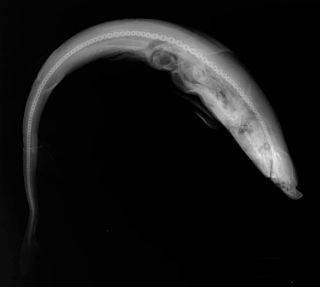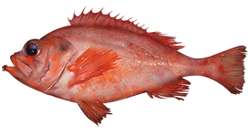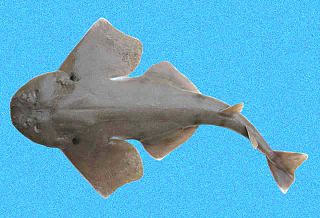
Mackerel is a common name applied to a number of different species of pelagic fish, mostly from the family Scombridae. They are found in both temperate and tropical seas, mostly living along the coast or offshore in the oceanic environment.

Herring are various species of forage fish, mostly belonging to the family of Clupeidae.

Zalophus is a genus of the family Otariidae of the order Carnivora.

The Nile perch, also known as the African snook, Goliath perch, African barramundi, Goliath barramundi, Giant lates or the Victoria perch, is a species of freshwater fish in family Latidae of order Perciformes. It is widespread throughout much of the Afrotropical realm, being native to the Congo, Nile, Senegal, Niger and Lake Chad, Volta, Lake Turkana, and other river basins. It also occurs in the brackish waters of Lake Maryut in Egypt. The Nile perch is a fish of substantial economic and food-security importance in East Africa. Originally described as Labrus niloticus, among the marine wrasses, the species has also been referred to as Centropomus niloticus. Common names include African snook, Victoria perch, and many local names in various African languages, such as the Luo name mbuta or mputa. In Tanzania, it is called sangara, sankara, or chenku. In Francophone African countries, it is known as capitaine. Its name in the Hausa language is giwan ruwa, meaning "water elephant".

The Atlantic goliath grouper or itajara, also known as the jewfish, is a saltwater fish of the grouper family and one of the largest species of bony fish. The species can be found in the West Atlantic ranging from northeastern Florida, south throughout the Gulf of Mexico and the Caribbean Sea, and along South America to Brazil. In the East Pacific it ranges from Mexico to Peru. In the East Atlantic, the species ranges in West Africa from Senegal to Cabinda. The species has been observed at depths ranging from 1 to 100 meters.

Wobbegong is the common name given to the 12 species of carpet sharks in the family Orectolobidae. They are found in shallow temperate and tropical waters of the western Pacific Ocean and eastern Indian Ocean, chiefly around Australia and Indonesia, although one species occurs as far north as Japan. The word wobbegong is believed to come from an Australian Aboriginal language, meaning "shaggy beard", referring to the growths around the mouth of the shark of the western Pacific.

The Ganges shark is a critically endangered species of requiem shark found in the Ganges River and the Brahmaputra River of India and Bangladesh. It is often confused with the more common bull shark, which also inhabits the Ganges River and is sometimes incorrectly referred to as the Ganges shark. The genus is currently considered to contain three recent species; genetic evidence has shown that both the Borneo river shark and Irrawaddy river shark should be regarded as synonyms of the Ganges shark, expanding the range of the species to Pakistan, Myanmar, Borneo, and Java. While the other members of the genus Glyphis occur in coastal marine waters as well as rivers, the Ganges shark is found only in fresh water, making it the world's only exclusively freshwater shark. The species remains poorly known and very rare.
The Amistad gambusia is an extinct species of small fish known only from a single locality, the large vegetated Goodenough Spring in Val Verde County, Texas. It apparently was driven to extinction in the wild when its habitat was submerged to a depth of about 70 feet by the construction of the Amistad Reservoir in 1968. The two captive populations, at the University of Texas System and the Dexter National Fish Hatchery in New Mexico, later failed through hybridization with the related mosquitofish and predation. The species has been classified as extinct by the United States Fish and Wildlife Service since 1987, and by the IUCN since 2013.

Irwin's turtle is a rare species of freshwater turtle in the family Chelidae. The species is endemic to Australia, originating from the lower region of the Burdekin River area in northern Queensland, and was named after conservationist and television personality Steve Irwin.

The Atlantic weasel shark is a weasel shark of the family Hemigaleidae, found in the eastern Atlantic Ocean. Also known as the little tiger shark, it is the only species of the genus Paragaleus to have been recorded off the western coast of Africa. It is one of four species of small sharks within the carcharhinoid genus Paragaleus, including Paragaleus leucolomatus, Paragaleus tengi, and Paragaleus randalli. It also one of eight species within the weasel shark family, Hemigaleidae. It is currently considered by the International Union for Conservation of Nature (IUCN) as Endangered.

Percilia is a genus of perch-like ray-finned fish in the monogeneric family Perciliidae.

Cavefish or cave fish is a generic term for fresh and brackish water fish adapted to life in caves and other underground habitats. Related terms are subterranean fish, troglomorphic fish, troglobitic fish, stygobitic fish, phreatic fish, and hypogean fish.

The Acadian redfish, also known as the Atlantic redfish, Acadian rockfish, or Labrador redfish, is a species of marine ray-finned fish belonging to the subfamily Sebastinae, the rockfishes, part of the family Scorpaenidae. It is native to the deep waters of the northwestern Atlantic.

Fuxian Lake is a body of water in Yunnan Province, China. It stretches through Chengjiang, Jiangchuan and Huaning Counties, spanning an area of 212 square kilometers. It is the third-largest lake in Yunnan, after Dian Lake and Erhai Lake, and the deepest, at 155 meters. It is the third-deepest fresh water lake in China, after Tianchi and Kanas Lake.

Diplomystes nahuelbutaensis is a species of velvet catfish endemic to Chile where it occurs in the Bío-Bío River basin and in the Loncomilla River. It grows to a length of 26.0 centimetres (10.2 in) TL and is a component of local commercial fisheries as well as being a gamefish.
Trypanosoma irwini is a blood parasite of koalas. First discovered in 2009 by Linda M. McInnes and her peers, it was named in honor of Steve Irwin, "The Crocodile Hunter". The study done by McInnes et al. was the first to describe a Trypanosoma species from koalas.

The disparate angelshark is a species of angelshark found along the East Coast of the United States and the Gulf of Mexico. It occurs at depths down to 1,290 m (4,230 ft) and reaches a length of 49 cm (19 in). Heteroptera in its name refers to the difference in size, shape and area of the two dorsal fins. Disparate angelsharks have the typical angel shark body form that is broadly flattened with large pectoral/pelvic fins and eyes and spiracles on the top of their heads. Their common and species name comes from them having dorsal fins of very different sizes, shapes, and areas compared to other angel sharks.
















